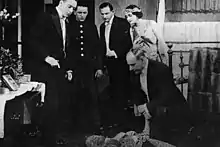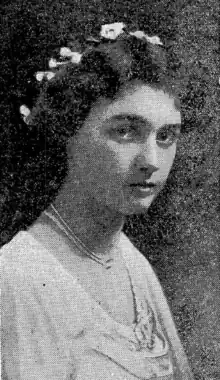| The Blue Mountains Mystery | |
|---|---|
 Hotel guests including Billy Williams (left) and Majorie Osborne examine the supposedly dead Henry Tracey (John Faulkner). | |
| Directed by | Raymond Longford Lottie Lyell |
| Written by | Raymond Longford Lottie Lyell |
| Based on | The Mount Marunga Mystery by Harrison Owen |
| Produced by | Dan Carroll E. J. Carroll |
| Starring | Marjorie Osborne John Faulkner |
| Cinematography | Arthur Higgins |
| Edited by | Lottie Lyell |
| Distributed by | Southern Cross Picture Productions[1] |
Release date | 5 November 1921[2] |
Running time | 6,000 feet[3] |
| Country | Australia |
| Languages | Silent film English intertitles |
| Budget | £4,000[4] |
The Blue Mountains Mystery is a lost 1921 Australian silent film directed by Raymond Longford and co-directed by Lottie Lyell.[5]
The film was derived from the 1919 novel The Mount Marunga Mystery by Harrison Owen. It is considered a lost film.[6]
Plot
The Blue Mountains Mystery involves the alleged murder of a wealthy businessman, Henry Tracey, and the eventual discovery that the victim was an underworld look-alike impersonator. The main suspects are Tracey's ward, Pauline, Mrs Tracey, and Pauline's boyfriend, Hector, and his rival, Richard Maxim.
Eventually the supposedly dead Henry Tracey reappears and announces that he had been kidnapped. The corpse was Stephen Rodder, a man with a strong resemblance to Tracey.
Cast
- Marjorie Osborne as Mrs Tracey
- John Faulkner as Henry Tracey/Stephen Rodder
- Vivian Edwards as Hector Blunt
- Bernice Vere as Pauline Tracey
- Billy Williams as Richard Maxim
- Redmond Barry as detective
- John de Lacey as Captain Banks
- Ivy Shilling as dancer
Production
The movie was mostly filmed in Katoomba, the Blue Mountains and Sydney Harbour, with some studio work at the Carrolls' Palmerston studio in Sydney. The Carrington Hotel and Hydro-Majestic Hotel were featured. Shooting took an unusually long time to complete, in part because of the location work involved.[4][7]
Marjorie Osborne was the only daughter of Charles Lord (son of Francis Lord) and Bertha Lord, née Kerr, later Mrs Emanuel de Beaupuis. She was a fashion consultant to the Sydney store of Farmer's, and wife of a wealthy land-owner, Henry Hill Osborne. She unsuccessfully attempted a Hollywood career after making this film.[4]
Drapery business established in 1839 by Joseph and Caroline Farmer which became a retail empire and social institution. Located initially opposite the Victoria Theatre in Pitt Street, it expanded into a purpose-built department store further south on Pitt Street in 1874.
It was Longford's third production for E. J. Carroll and the first in which Lyell received a formal co-direction credit. According to the book Australian Cinema: The First 80 Years by Graham Shirley and Brian Adams, the film cost almost double that of The Sentimental Bloke (1919).
Reception

The film was popular at the box office in Australia.[4][8]
Although now lost, at the time of its release The Blue Mountains Mystery fared well in the United Kingdom, South America and the United States upon its initial release.[9] The London Bioscope wrote of The Blue Mountains Mystery: " …by its restrained acting, shows the force which a story gains in the telling. As a consequence, suspense is held throughout".[10] The reviewer of the Los Angeles Times said the film "will keep you on the edge of your seat to the last fade out."[11]
Actress Marjorie Osborne was admiring of Lottie Lyell's contributions for The Blue Mountains Mystery. She said of her: "I like brains in a woman, and she has them. Her work on this picture is more on the directing side than the acting. She assists Mr. Longford, and the two of them have plenty of healthy argument when their ideas about a scene are different."[12] The November 1921 edition of the Picture Show magazine also praised Lyell as being "enthusiastic, original, possessing charm and common sense" for her writing of the screenplay.
Harrison Owen was unimpressed with the film, which he thought poorly made compared to overseas movies.[13]
The Carrolls withdrew from production after this film and concentrated on distribution and exhibition.
Resources
- Shirly, Graham; Adams, Brian (1983). Australian Cinema: The First 80 Years. Angus & Robertson Publishers. ISBN 0-207-14581-4.
- Harrison, Owen (1919). The Mount Marunga Mystery. Kessinger Publishing. ISBN 0-548-83250-1.
References
- ↑ "SOUTHERN CROSS (FEATURE FILM COMPANY, LIMITED)". The Register. Adelaide. 23 December 1921. p. 5. Retrieved 28 July 2012 – via National Library of Australia.
- ↑ "THE LYCEUM". The Sydney Morning Herald. 5 November 1921. p. 14. Retrieved 28 July 2012 – via National Library of Australia.
- ↑ "Raymond Longford", Cinema Papers, January 1974 p. 51
- 1 2 3 4 Andrew Pike and Ross Cooper, Australian Film 1900–1977: A Guide to Feature Film Production, Melbourne: Oxford University Press, 1998, 110.
- ↑ Everyones, Everyones Ltd, 1920, retrieved 4 June 2018
- ↑ "The Blue Mountains Mystery". silentera.com. Retrieved 25 February 2013.
- ↑ The Bulletin, John Haynes and J. F. Archibald, 1880, retrieved 4 June 2018
- ↑ The bulletin, John Haynes and J. F. Archibald, 1880, retrieved 4 June 2018
- ↑ "Australian Pictures in America". The Register. Adelaide. 3 March 1922. p. 6. Retrieved 1 September 2013 – via National Library of Australia.
- ↑ Bioscope, quoted by Everyones, 4 November 1924
- ↑ THREE NEW PLAYS OPEN THIS WEEK Los Angeles Times 24 June 1923: III27.
- ↑ Ibid., 1 November 1921
- ↑ "London Life". The West Australian. Perth. 15 May 1922. p. 10. Retrieved 28 July 2012 – via National Library of Australia.